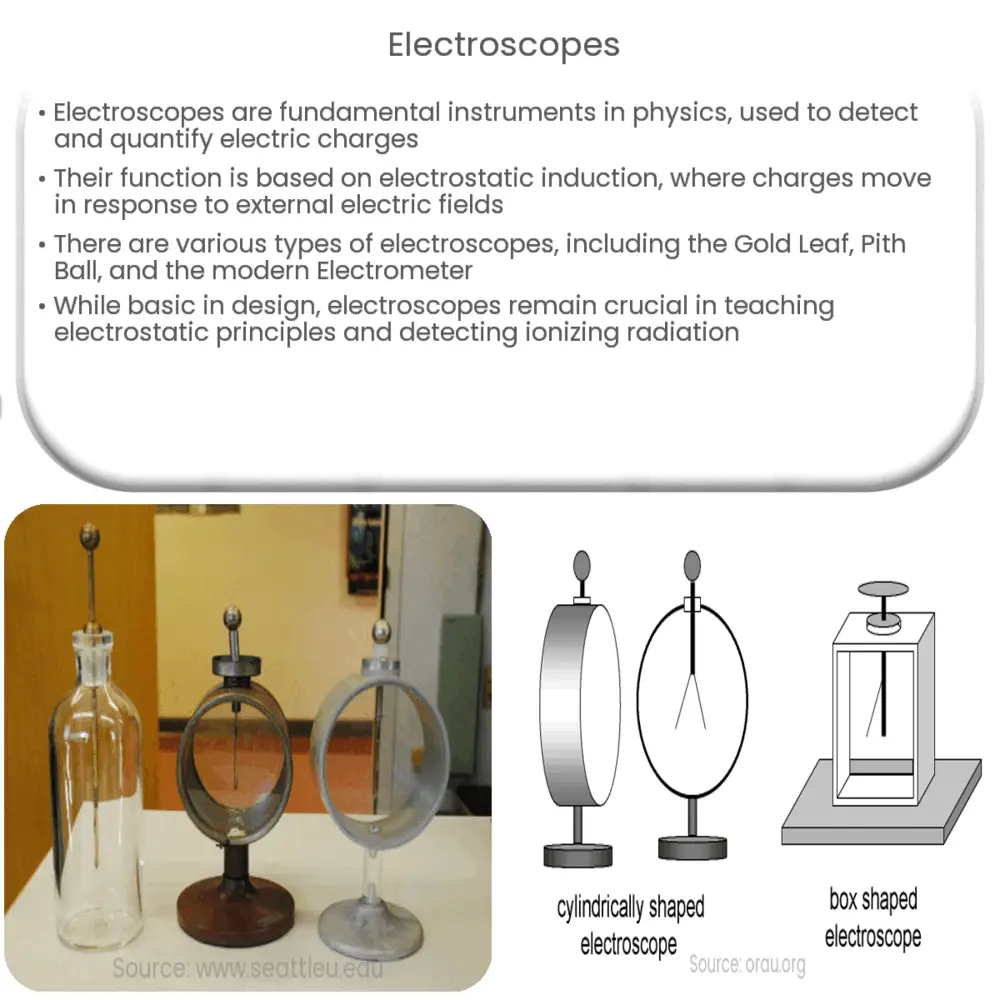Explore the workings of an electroscope, its types, applications, and role in radiation detection in our comprehensive guide.

Understanding Electroscopes
An electroscope is a fundamental instrument in the field of physics, known for its ability to detect and quantify electric charge. This apparatus, although simple in design, has been a staple of electrostatic experiments since its inception.
The Basic Principle
The working principle of an electroscope lies in the phenomenon of electrostatic induction. It involves the movement of charges in response to an external electric field, causing the gold leaves or aluminum foil strips inside the electroscope to separate.
The Design
A standard electroscope consists of a metal rod that extends into a jar or flask. At the top of the rod, there is a metal ball or disk, often referred to as the cap. Inside the jar, attached to the bottom end of the rod, there are two thin gold leaves or strips of lightweight metal that hang freely. The entire apparatus is typically enclosed to protect it from air movements and ions that could interfere with its operation.
Types of Electroscopes
- Gold Leaf Electroscope: This is the most common type, historically. It consists of two thin gold leaves which spread apart when the electroscope is charged.
- Pith Ball Electroscope: Instead of gold leaves, this variant uses a small lightweight ball. This ball gets repelled from the stem when a charge is introduced, indicating the presence of an electric charge.
- Electrometer: This is a more modern version of the electroscope that is able to not only detect but also measure electric charge with higher precision.
Understanding Charge Detection
The basic operation of an electroscope is straightforward. When a charged object is brought near the cap of the electroscope, the free electrons in the metal rod react. If the object has a negative charge, electrons in the rod are repelled downwards causing the gold leaves to diverge. Conversely, a positively charged object will attract the electrons up the rod, leaving a positive charge on the leaves, which again causes them to separate.
Importance in Physics
The electroscope, while simple, is a foundational device in the study of electrostatics. Despite its age, it continues to play a vital role in illustrating and understanding the behavior of electric charges, making it a popular teaching aid in physics classrooms worldwide.
Applications of Electroscopes
Electroscopes, due to their practical design and reliable function, have various applications. They are primarily used in laboratories to identify electrically charged bodies. Electroscopes are also a key component in teaching the concepts of electrostatics in educational settings. Furthermore, they have uses in the study of radiation, as radioactive materials ionize air, causing the electroscope to discharge.
Electroscope in Radiation Detection
The electroscope’s ability to detect ionizing radiation gives it a significant role in radiation physics. In this context, it functions as a basic radiation dosimeter. The principle is simple: when the electroscope is charged, it will gradually lose its charge if exposed to ionizing radiation. The rate of charge leakage is a measure of the amount of ionizing radiation the electroscope is exposed to.
Modern Electroscopes
With the advance of technology, electroscopes have evolved as well. Contemporary electrometers, the high-tech version of an electroscope, offer digital readouts and can measure extremely low levels of charge. They can also measure both positive and negative charges, adding to their utility in research and industry.
Limitations
Despite its many benefits, an electroscope has certain limitations. It can only detect the presence of an electric charge, not its amount. Additionally, it can’t differentiate between positive and negative charges. These limitations, however, do not overshadow its fundamental role in physics and its utility as a teaching aid.
Conclusion
In summary, an electroscope is a remarkably simple yet effective device in the world of physics. Despite its age and the rise of more sophisticated instruments, it remains a key tool for visualizing and understanding the fundamental principles of electrostatics. Furthermore, its ability to detect ionizing radiation extends its utility beyond just physics, reaching into the realms of nuclear chemistry and health physics. As a tool for both instruction and basic measurement, the humble electroscope continues to hold its own in our high-tech world.

